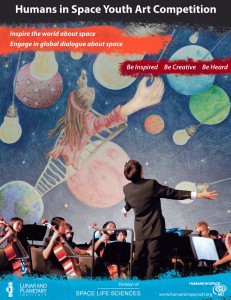May is the target time for a novel effort by the Humans in Space Youth Art Competition.
A “moon bounce performance” is slated using artwork in collaboration with visual artist, Daniela DePaulis, and the Dwingeloo Radio Telescope in The Netherlands.
OPTICKS is a live radio transmission performance between the Earth and the Moon during which images are sent to the Moon and back as radio signals.
“From the art end, we are all set and have what we need,” said Jancy C. McPhee, Director of the Humans in Space Youth Art Competition at the NASA Johnson Space Center. Selected paintings will be bounced off the Moon.
The date for bouncing the artwork off the Moon will depend on ensuring that the radio telescope is working properly and on schedule, “as with any ‘science’ experiment,” she said.
Future of space
The international Humans in Space Youth Art Competition encourages youth to “Be Inspired, Creative and Heard” and is dedicated to inspiring the world about space via a global dialogue on the future of space.
The 2012-2013 competition invited young people from 10 to18 years of age to submit visual, literary, musical and video artwork expressing their vision. The winning artwork is woven into displays and performances designed to relay the youth artists’ messages to other young people and adults around the world.
The main 2012 partners in the Humans in Space Youth Art Competition were NASA, the German Aerospace Center (DLR), the Universities Space Research Association (USRA), the Lunar and Planetary Institute, and Mission X, an international educational challenge focused on fitness and nutrition that encourages students to “train like an astronaut.”
Reflect on this
The OPTIKS project has been realized by artist de Paulis in collaboration with Jan van Muijlwijk and the CAMRAS radio amateurs association based at the Dwingeloo radio telescope in The Netherlands.
OPTICKS employs a technology called Earth-Moon-Earth (EME) or Moonbounce, developed shortly after World War II by the U.S. military as a form of reliable radio communication.
The long and short of the idea: EME uses the Moon as a natural reflector for radio signals. When the radio signals hit the Moon’s surface they are scattered in all directions so that only a small percentage of the original signals is reflected back on Earth.
Newton inspired
The title OPTICKS is inspired by Sir Isaac Newton, an English physicist and mathematician that, among other scientific inquiries, developed theories on light spectrum, reflection and refraction.
For the OPTICKS work, colors composing an image, converted into radio signals, are bounced off the Moon (reflected and refracted) by its surface during each live performance.
The project has been performed internationally, both in art festivals and science outreach events, including Global Astronomy Month 2011 and 2012.
Artwork
Promotional artwork for the 2012 Humans in Space Youth Art Competition melded two renderings: The background piece, called “Industrializing Space,” was done by Jessica Sun, 15 years old, United States. She was awarded: 2nd Overall Visual Art Age 14-18.
In the foreground, the young man conducting the orchestra overlain on top of the painting is from the 2010 Humans in Space Youth Art Competition. He is shown conducting the Clear Lake High School orchestra playing his winning music composition for an assembled audience at the Opening Ceremony of the International Academy of Astronautics’ Humans in Space Symposium in Houston, April 2011. His name is James Tabata, age 16 (back in 2010), United States, 1st place overall, music, age 14–17.
Want more information?
NOTE 1:
For more information on the Humans in Space Youth Art Competition, go to:
NOTE 2:
Tabata’s musical artwork is visible here, as played during a live Houston performance:
https://www.youtube.com/watch?v=4ChTOnq1OeU&feature=plcp
NOTE 3:
More information on OPTICKS and Visual Moonbounce can be found at:
By Leonard David

